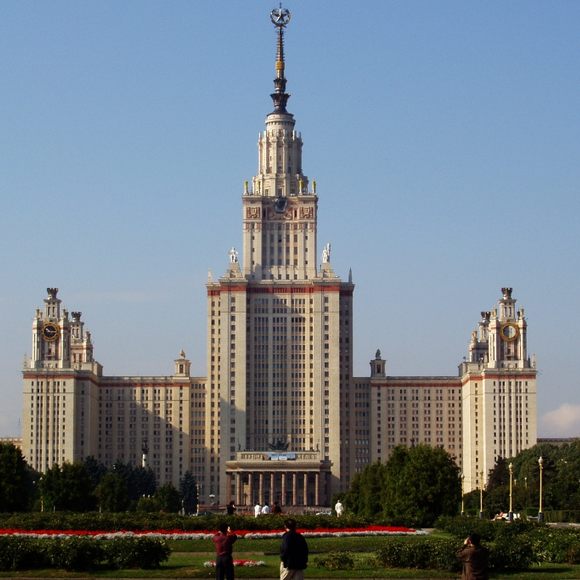The main building of Moscow State Lomonosov University looks more like a piece of scenery from a Batman movie than the home to the most prestigious institution of higher education in all of Russia. This building is the largest of fabled Seven Sisters of Moscow, a series of neo-gothic skyscrapers built in elaborate imperial style of Stalin’s era. Its design is work of Lev Vladimirovich Rudnev. The construction started in 1949 and at 240m tall, for decades it was the tallest building in Europe.
Since the beginning of its construction the main building of Moscow State University was a center of numerous legends. One apocryphal story is that the material for its construction was originally prepared by Hitler for his gigantic building projects in Berlin. Allegedly, it was looted by the invading Red Army and transported back to Russia.
What is known is that German prisoners of war provided much of the manual labor on the construction site and some of them were housed on the 24th and 25th level of the main tower. According to one unlikely story, at the end of the construction hundreds, perhaps, thousands of them were walled in alive there. Some claim to have seen prisoners trying to jump to freedom on improvised plywood gliders.
Another apocryphal story claims that the foundation of the buildings are built of too soft ground. Supposedly, the soil requires constant freezing using giant cryo equipment in the basement of the building. This story is probably a result of a mixup with Red Gates administrative building, another of Stalin’s skyscrapers which actually did require the use of cryotechnology during its construction. Yet another story claims that the building runs as deep underground as it did above, concealing secret study centers and a maze of tunnels leading directly to Stalin’s personal country house.
Legends aside, this gargantuan edifice is remarkable in its own right. The main tower, consumed over 40,000 metric tons of steel alone. 240 m tall, 36 stories high, it consists of 35km of corridors and has over 5000 rooms. In addition to housing entire faculties of Mechanics and Mathematics, Geology, Geography, and Fine and Performing arts its facilities include a concert hall, a theatre, a museum, various administrative services, a library, a swimming pool, a police station, a post office, a laundry, a hairdresser’s salon, several canteens, bank offices and ATMs, shops, cafeterias, a bomb shelter, etc.
The star on the top of the tower is large enough to include a small room and a viewing platform; it weighs 12 tons. The building’s facades are ornamented with giant clocks, barometers, thermometers, statues, and carved wheat sheaves.
Community Contributors
Added by
Edited by
Plan Your Trip
The Atlas Obscura Podcast is Back!

























Follow us on Twitter to get the latest on the world's hidden wonders.
Like us on Facebook to get the latest on the world's hidden wonders.
Follow us on Twitter Like us on Facebook